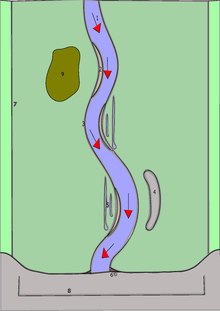In geology, a backswamp is a type of depositional environment commonly found in a floodplain. It is where deposits of fine silts and clays settle after a flood. These deposits create a marsh-like landscape that is often poorly drained and usually lower than the rest of the floodplain.
Levees form as a result of the flooding process. Large amounts of rainfall cause the river to become too full during the flooding, where it overflows, carrying sediments into the floodplain. As the flooding slows and stops, the sediments are deposited, with the largest deposited closer to the river channel and the smaller ones deposited further away. These deposits result from the larger sediments losing energy faster than their smaller counterparts, which results in the creation of levees which are natural embankments that are close to the channel and help keep the river from flooding in the future.
When another flooding event occurs, the water level rises over the levees and floods the floodplains. As the flooding event stops, the water and all of the sediments it carried cannot drain out back into the river’s main channel due to the levees, a backswamp forms.

Backswamps often occur in meandering river settings because they consist of a single highly sinuous channel that’s continuously being affected by erosion. This meandering allows for the creation of oxbow lakes, as well as backswamps as shown in the figure above. These result from the river’s meanders becoming too loopy and significant with increased erosion, causing the river to make a “short cut” by combining two or more of the river’s bends called meander scrolls.
Backswamps have a poorly drained marsh-like landscape, which results in the soils around these depositional environments being anoxic. The anoxic environment results from poorly drained areas, resulting in high microbial activity due to low oxygen availability. The anoxic settings can cause the soil to change as a result of redox reactions. Because of the anoxic environment, there isn't much oxygen which means the redox reactions have to find new terminal electron acceptors for these reactions. Once the redox reactions have used up all the available oxygen in the soil, they move on to nitrogen, iron, manganese, and sulfate in that order. These processes cause redoximorphic features, which render color changes in the surrounding soils.
See also
References
- Chen, Yin-Hsuen; Mossa, Joann; Singh, Kunwar K. (2020-04-01). "Floodplain response to varied flows in a large coastal plain river". Geomorphology. 354: 107035. Bibcode:2020Geomo.35407035C. doi:10.1016/j.geomorph.2020.107035. ISSN 0169-555X. S2CID 213092381.
- Adams, Peter N.; Slingerland, Rudy L.; Smith, Norman D. (2004-07-01). "Variations in natural levee morphology in anastomosed channel flood plain complexes". Geomorphology. 61 (1–2): 127–142. Bibcode:2004Geomo..61..127A. doi:10.1016/j.geomorph.2003.10.005. ISSN 0169-555X.
- Marriott, Susan (1992). "Textural analysis and modelling of a flood deposit: River severn, U.K." Earth Surface Processes and Landforms. 17 (7): 687–697. Bibcode:1992ESPL...17..687M. doi:10.1002/esp.3290170705. ISSN 1096-9837.
- Cazanacli, Dan; Smith, Norman D. (1998-10-01). "A study of morphology and texture of natural levees—Cumberland Marshes, Saskatchewan, Canada". Geomorphology. 25 (1–2): 43–55. Bibcode:1998Geomo..25...43C. doi:10.1016/S0169-555X(98)00032-4. ISSN 0169-555X.
- Donovan, Mitchell; Belmont, Patrick; Sylvester, Zoltán (2021). "Evaluating the Relationship Between Meander-Bend Curvature, Sediment Supply, and Migration Rates". Journal of Geophysical Research: Earth Surface. 126 (3): e2020JF006058. Bibcode:2021JGRF..12606058D. doi:10.1029/2020JF006058. ISSN 2169-9011. S2CID 233962264.
- Hooke, Janet (2003). "River meander behaviour and instability: a framework for analysis". Transactions of the Institute of British Geographers. 28 (2): 238–253. Bibcode:2003TrIBG..28..238H. doi:10.1111/1475-5661.00089. ISSN 1475-5661.
- Humphries, Marc (2008). Sedimentation and chemical processes on the Lower Mkuze floodplain : implications for wetland structure and function (Thesis thesis).
- Vepraskas, Michael J.; Lindbo, David L.; Stolt, Mark H. (2018-01-01). "Redoximorphic Features". Interpretation of Micromorphological Features of Soils and Regoliths: 425–445. doi:10.1016/B978-0-444-63522-8.00015-2. ISBN 9780444635228.
| Wetlands | |||||
|---|---|---|---|---|---|
| Types and landforms | |||||
| Life | |||||
| Soil mechanics | |||||
| Processes | |||||
| Classifications | |||||
| Conservation |
| ||||
| Related articles | |||||
This geomorphology article is a stub. You can help Misplaced Pages by expanding it. |